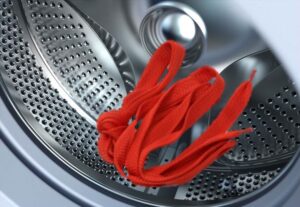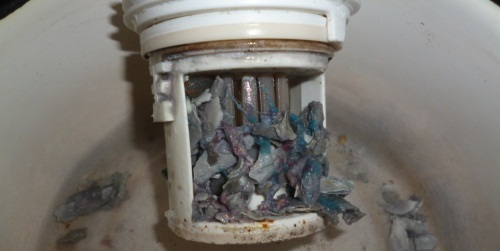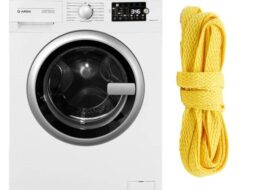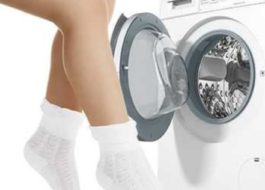A string is stuck in the washing machine drum
 It is no coincidence that manufacturers recommend washing small items, children's socks, girdles and underwear, in specially designed bags. Otherwise, at the end of the wash, the user will be in for a “surprise” - something that was put into the machine will disappear. More precisely, when the cylinder is untwisted, it will fall into the tank. If the cord is stuck in the drum of the washing machine, then you cannot leave it like that - the system may become clogged and break down. It is better to go in search of the “lost thing”.
It is no coincidence that manufacturers recommend washing small items, children's socks, girdles and underwear, in specially designed bags. Otherwise, at the end of the wash, the user will be in for a “surprise” - something that was put into the machine will disappear. More precisely, when the cylinder is untwisted, it will fall into the tank. If the cord is stuck in the drum of the washing machine, then you cannot leave it like that - the system may become clogged and break down. It is better to go in search of the “lost thing”.
Is there really a lost cord in the drum?
If you don’t see laces among the washed items, don’t panic and immediately disassemble the washing machine. The rope does not always get stuck in the tank or drum - perhaps it got caught in another place. First we do this:
- we probe the drum cylinder (sometimes the lace sticks to the wall or clings to the rib punch);
- We carefully check the things taken out of the drum (often the rope is “hidden” in pockets or folds);
- inspect the cuff of the hatch (bend the elastic band back and look for the lace).
If the lost cord was not found in the mentioned places, it means that it managed to fall into the tank. As a rule, due to its low weight, the rope does not stay there, but “goes” along with the water into the drainage system. More precisely, it is wound onto a garbage filter or pump volute. To remove the product, you will have to disconnect the machine from communications, open the technical hatch door, lay down rags and unscrew the drainage nozzle. Afterwards, all that remains is to inspect the vacated hole and find the “lost thing”.
Operating a washing machine with an object stuck in the tank is dangerous - the item can clog the drain or cause the heating element to break down.
It is more difficult when the lace remains in the tank. You can get it in several ways, but it’s better to start with the simplest:
- start the rinse program with an empty drum;
- wait until the machine is “washed”;
- At the end of the cycle, check the garbage filter and snail.
There is a high probability that after repeated rinsing, the stuck string will leave the tank along with the water, remaining on the filter or snail. If the method does not work, then you should turn to more effective measures. It is strongly not recommended to leave the rope inside the machine - it can stick to the heater and cause its breakdown.
The pipe between the tank and the snail
On washing machines without a tray, you can get the stuck cord out through the bottom. It is enough to unhook the drain pipe from the tank and take the “lost” out. The procedure is as follows:
- disconnect the machine from communications;
- remove the powder receptacle;
- carefully lower the washer onto its left side;
- look under the bottom and find a black or gray hose on the tank;

- loosen the clamp fixing the pipe;
- Unhook the hose from the tank.
Afterwards, all that remains is to shine a flashlight through the hole and inspect the tank. Sometimes the lace falls out on its own, but often you have to force it out. In the latter case, you will have to use your fingers or a wire bent into a “hook”.
You can remove the cord from the tank through the hole in the drain pipe or heating element, depending on the model of the washing machine.
If the washing machine has a tray and protects the body from leaks, then it is better to abandon this method.Disabling the Aquastop system is not an easy task, which only professionals can handle. It’s better not to risk it and get to the drain pipe another way or refuse to “hack” it yourself. The ideal option is to contact the service for professional help.
Through the “socket” for the heater
On washing machines in which the heater is located on the back side under the tub, you can remove the stuck object through the hole in the heating element. Moreover, it is here that the “lost ones” cling, clinging to the hot spiral. You cannot leave a rope or other small thing here - the machine will stop heating at full strength, and the element itself will quickly burn out.
Before any repair operations, make sure that the washing machine is disconnected from the water supply and electricity supply!
To remove the cord from the tank, you will first have to remove the heating element. We are guided by the following instructions:
- turn off the power to the washing machine;
- turn off the water supply tap;
- turn the machine with the back panel towards you;
- remove the “backdrop” by unscrewing the bolts holding it;

- find the heating element “chip” under the tank;
- release the heater from the connected wiring;
- loosen the central nut without unscrewing completely;
- press the rod inward so that it is “even” with the nut;
- use a rocking motion to remove the heating element from the “socket” (do not pull the heater by the connected wires - this can damage the power circuit);
- treat the heating element with WD-40 cleaner if the heating element does not work.
As a rule, the lace is pulled out along with the heating element, since the rope clings to the spiral. If the heater is “clean”, then you need to shine a flashlight through the hole and find the “lost” one. The item is obtained using an inserted hand, a screwdriver or a bent wire.
After “releasing” the cord, it is recommended to carefully inspect the heater for defects. It is possible that even short-term contact with a foreign object damaged the heating element. If there is noticeable damage, cracks or chips on the surface of the element, it must be replaced. Ideally, even visually the entire device should be checked with a multimeter. A replacement replacement is selected based on the serial number of the washing machine.
After all the manipulations, the washing machine needs to be assembled. We follow the instructions described, only in reverse order. At the “finish”, we make sure to carry out a test wash, checking the correct installation of the heating element, drain pipe or garbage filter. Let’s not forget about “working on mistakes”: from now on, it’s better to wash small items in special protective bags.
Interesting:
Reader comments
- Share your opinion - leave a comment
Categories
Washing machine repair


For buyers

For users

Dishwasher

















Add a comment